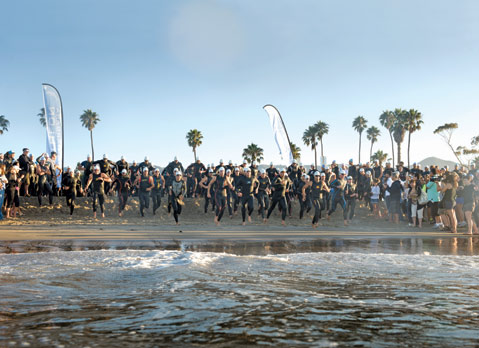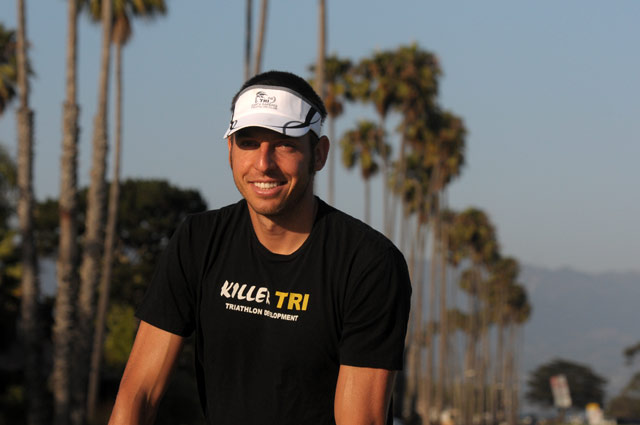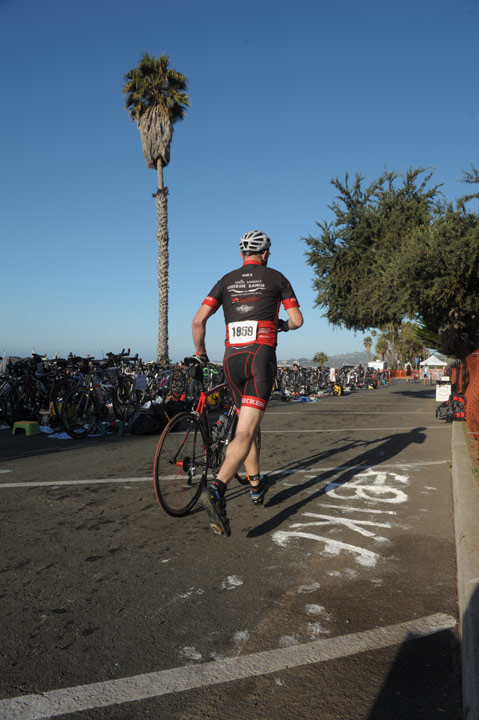The Race Is On
The S.B. Triathlon and the Mechanics of Running

On your toes, everybody. That goes for the competitors in this weekend’s 31st annual Santa Barbara Triathlon, as well as the organizers of the sprawling event.
Anxious athletes will be lined up at East Beach early Saturday, August 25, ready to plunge into the ocean for the first stage of the long-course triathlon, a one-mile swim. Race director Joe Coito hopes that a conspicuous great white shark does not conspire with city officials to strand the swimmers on the shore.
Several shark sightings last week activated a city policy to post swim-at-your-own-risk warnings on the beaches. “City lifeguards oversee our swim course,” Coito said. “If the lifeguards are not out there, we’re not swimming.”
Coito said a beach run would probably be substituted if the swim were cancelled. “It wouldn’t be the first time we made a decision on the fly,” he said. A few years ago, thick fog rolled in, and the swimmers were in danger of losing their way because they couldn’t see the buoys marking the course. “We reduced the swim to a half mile,” Coito said.
He still was able to preserve the swim/bike/run combination that has spelled triathlon ever since the first such competition was staged at San Diego’s Mission Bay in 1974.The sport grew in popularity around the world and made its Olympic debut in 2000. The triathlon is one of three Olympic sports invented in the United States — the others being basketball and volleyball.
In Santa Barbara, which hosts one of the country’s oldest triathlons, it has become synonymous with a healthy lifestyle. Close to 2,000 people have signed up for this weekend’s event, which also includes a sprint course on Sunday. Hundreds of them are area residents of all ages who have incorporated swimming, bicycling, and running into their daily routines.

In the Running
Kyle Visin is at the forefront of the hometown crowd. He is president of the Santa Barbara Triathlon Club and will represent the community this fall in the most famous of all triathlons, the Ironman World Championship in Kona, Hawai‘i.
Visin has lately been sharing his passion for the triathlon with anybody who approaches him with an interest in putting together the best swim/bike/run they can. In partnership with Bob Wilcher, a trainer who runs the Killer B Fitness gym on the corner of Turnpike Road and Hollister Avenue, he has started a program known as Killer Tri.
A key component of the program is attention to the mechanics of running. The closing run — from two miles in Santa Barbara’s sprint course to a 26.2-mile marathon in the Ironman — makes or breaks a triathlete. It is the phase that is most likely to leave him or her with chronic injuries.
It was Wilcher, a former college basketball player, who came up with the concepts that he and Visin teach. “I ran a marathon after college, and I ended up with patellar tendinitis,” Wilcher said. “Every time I tried to run, I had this nagging pain deep in my knee. I had an ex-girlfriend who kind of led me on to the idea. When she ran, she landed on her mid-foot, not on her heel like me. That got me thinking. I did a lot of research on the Internet. I realized that there is a mechanics of running. Professional runners like Haile Gebrselassie wouldn’t even think about it, because they’ve basically been doing it their whole life. We’re trying to take the concepts ingrained in them and teach them to the average runner that makes up 99 percent of runners. We don’t have to be as fast as the elite — we never will — but we can run the way they do and enjoy the benefits of long-term running.”

Wilcher looked to nature as well as Olympic champions for inspiration. “Look at cats, dogs, cheetahs; they’re always like this,” he said, going into a half-crouch, “ready to attack. When you’re at your ready position in basketball or tennis or soccer, where’s your pressure? It’s on your mid-foot. If you’re back on your heels, you’re slow. You get someone on their heels, they’re done. You’ve got to be on your mid-foot.”
Visin, who graduated from UCSB with a degree in mechanical engineering, was intrigued by Wilcher’s analysis. He modified his approach while training for the Hawai‘i Ironman in 2010. “I wasn’t thinking that it was going to make me enjoy running more and stay injury-free,” Visin said. “I was of the mindset this was going to make me faster. But that was not the biggest benefit of my learning it. I noticed a decrease in injuries. I put on a hefty amount of mileage from week to week, and I’d be sore, but the groups of muscles that are supposed to be sore — not your knees, not your ankles, not your joints. It allowed me to be much more consistent in my training.”
Wilcher noted, “I can’t tell you how many people have decided they hate running, running sucks, they never want to do it. It’s the wrong attitude to have. They have to learn that there’s a technique, like swimming, like cycling. If you twist and turn at your computer, you’re going to have an injury. It’s the same with running. I’m passionate about helping people enjoy running as a form of exercise.”
But work has to be done before running becomes play. “If someone comes to you and says, ‘I don’t know how to swim,’ do you work on their stroke technique or throw them a lifejacket?” Visin said. “If you throw them a lifejacket, they won’t drown, but that’s not swimming. Everybody’s looking for that quick fix. ‘Oh, I want to improve, so I’m going to get the greatest running shoes.’ Instead of putting a Band-Aid on the problem, we like to look at your running form and fix that first.

“With our running clinics, the first thing we do is take them out and videotape them to see how they run. In a few hours, they get the basic concepts. That’s not the most difficult part. Then we videotape them again. The most important thing is we give them a strategy, how to adopt their running form over a period of time. If you go out and run 10 to 50 miles a week, you might see a decrease in your performances at first, you might be sore in new places. It took me about three months to get a handle on it and about six months before I could run that way without thinking about it.
“We videotape people running by in Nite Moves, and 95 percent of them lead with their heels. When you lead with your heel, especially with today’s cushioned shoes, you don’t feel the impact,” Visin continued, “but when you’re doing that thousands of times over the course of even a 30-minute run, you’re creating all sorts of stress on your joints. There’s a lot of mechanics that go into it. The gist of it is you want a more compact running style and you want your foot to strike underneath you. Then you’re naturally going to go toward the mid- or forefoot, and you’ll have a bend in your knee, and that will create a nice cushion when you land. You’re going to be absorbing the shock of your landing with your joints the way they’re supposed to be, not totally extended.”
Beyond the technical instruction, it’s the camaraderie of aspiring athletes that keeps them motivated. “You have this community of people around you,” Visin said. “If you’re suffering, there’s someone suffering with you. People look forward to workouts as opposed to dreading them. The core of our group takes their training seriously, but they are not elite athletes. That’s the best part. You go to a triathlon or 5k, there are 10 guys out front who are really fast, but most are not elite athletes. They’re there for exercise, fun … that’s what we’re bringing to these programs.”
The methods are catching on, and people are now coming from all over the state to train here for triathlons. Take Eric Gronroos, a tax consultant from Pasadena who graduated in 1985 from UCSB, where he played rugby. “I wanted to get into shape,” said Gronroos, so he settled on the Santa Barbara Triathlon and found out about Killer Tri on the Internet. It was ocean swimming that presented him with the most difficulty.
“The first time I tried swimming off East Beach, it was so disorienting I thought about quitting,” Gronroos said. Visin’s advice: “Do it again. It’s not abnormal to be uncomfortable.” So Gronroos returned last week to do the Nite Moves swim off Leadbetter Beach. Dozens of swimmers splashed into the surf in spite of a shark scare — a great white had been spotted the previous day. “I didn’t think about it until everybody left me behind and I’m swimming by myself,” Gronroos said.
When he finished in one piece, Gronroos was dripping with confidence. “I’m ready to do it,” he said, ready to become a triathlete.




